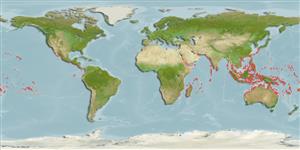Classification / Names
आम नाम | उपशब्द | Catalog of Fishes (gen., sp.) | ITIS | CoL | WoRMS | Cloffa
ऐकटीनोप्टीरेजी (रेज़-फिन्नढ मछलियाँ) >
Perciformes (Perch-likes) >
Carangidae (Jacks and pompanos) > Trachinotinae
Etymology: Trachinotus: Greek, trachys, -eia, -ys = rough + Greek,noton = back (Ref. 45335).
पर्यावरण / जलवायु / सीमा
पारिस्थितिकी
; समुद्री; खारा प्रवाल-भित्ति संयुक्त; गहराई सीमा 1 - 7 m (Ref. 5439). Tropical, preferred 28°C (Ref. 107945); 32°N - 32°S
Indo-Pacific: Red Sea and East Africa (Ref. 3287) to the Marshall Islands and Samoa, north to southern Japan, south to Australia.
Length at first maturity / आकार / वज़न / Age
Maturity: Lm ?, range 58 - ? cm
Max length : 110 cm FL पुल्लिंग / अलिंग; (Ref. 1602); common length : 40.0 cm TL पुल्लिंग / अलिंग; (Ref. 3280); अधिकतम प्रकाशित वज़न: 3.4 kg (Ref. 40637)
पृष्ठीय रीढ़ (सम्पूर्ण): 7; पृष्ठीय सौफट रेज़ (सम्पूर्ण): 18-20; गुदा कांटा 3; ऐनल सौफट रेज़: 16 - 18.
Juveniles inhabit sandy shorelines and shallow sandy or muddy bays near river mouths while adults move out in schools to clear seaward coral and rock reefs (Ref. 5213). Juveniles are in small schools, while adults are usually solitary (Ref. 48635). Adults feed primarily on sand mollusks and other hard-shelled invertebrates (Ref. 9710).
Life cycle and mating behavior
परिपक्व अवधि | पुनरुत्पत्ति | मछलीऔ का अंडे देना | अंडे | Fecundity | लार्वा
Paxton, J.R., D.F. Hoese, G.R. Allen and J.E. Hanley, 1989. Pisces. Petromyzontidae to Carangidae. Zoological Catalogue of Australia, Vol. 7. Australian Government Publishing Service, Canberra, 665 p. (Ref. 7300)
IUCN Red List Status (Ref. 115185)
CITES (Ref. 94142)
Not Evaluated
Threat to humans
Reports of ciguatera poisoning (Ref. 30911)
Human uses
मात्स्यिकी: लघु वाणिज्य; जलीयकृषि: व्यापारिक; आखेट मत्स्य: हां; जलजीवालय: सार्वजनिक लजीवालय
साधन
Special reports
Download XML
इंटरनेट स्रोत
Estimates of some properties based on models
Phylogenetic diversity index (Ref.
82805): PD
50 = 0.5000 [Uniqueness, from 0.5 = low to 2.0 = high].
Bayesian length-weight: a=0.03388 (0.01588 - 0.07232), b=2.84 (2.65 - 3.03), in cm Total Length, based on LWR estimates for this species & (Sub)family-body (Ref.
93245).
Trophic Level (Ref.
69278): 3.7 ±0.46 se; Based on food items.
लौटाव (Ref.
69278): माध्यम, न्यूनतम जनसंख्या दुगनी होने का समय 1.4 - 4.4 वर्ष। (Assuming tm=2-4).
Vulnerability (Ref.
59153): High vulnerability (62 of 100) .
